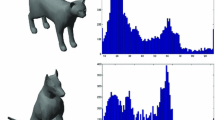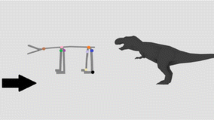Abstract
This paper proposes a novel shape feature description based on salient points, called Bag-of-Salience-Points (BoSP). The proposed descriptor is compact and provides a fast solution for finding the correspondences of two set of salient points, contributing to speed-up the task of shape matching. The novelty of the proposed descriptor lies in combining local sparse features (salient points) encoded in global and spatial-based histograms with a few other shape factors like eccentricity. The proposed shape descriptor retrieves the best matching, even in occlusions situations, where points in the two shapes cannot be properly matched. The BoSP is validated on several benchmark datasets for 2D shape matching algorithms, and it is observed that the BoSP maintains superior discriminative, while being invariant to geometric transformations as well as demanding a low computational cost to measure the similarity of shapes.









Similar content being viewed by others
References
Alajlan N, Kamel MS, Freeman GH (2008) Geometry-based image retrieval in binary image databases. IEEE Transactions on Pattern Analysis and Machine Intelligence 30:1003–1013
Andaló F, Miranda P, da S. Torres R, Falcão A (2010) Shape feature extraction and description based on tensor scale. Pattern Recogn 43(1):26–36
Arica N, Vural FTY (2003) Bas: a perceptual shape descriptor based on the beam angle statistics. Pattern Recogn Lett 24(9–10):1627–1639
Arulmozhi P, Abirami S (2014) Shape based image retrieval: a review. Int J Comp Sci Eng 6:14–153
Bai X, Latecki LJ (2008) Path similarity skeleton graph matching. IEEE TRANS PAMI 30(7)
Bai X, Rao C, Wang X (2014) Shape vocabulary: a robust and efficient shape representation for shape matching. IEEE Trans Image Process 23(9):3935–3949
Belongie S, Malik J, Puzicha J (2002) Shape matching and object recognition using shape contexts. IEEE Transactions on Pattern Analysis and Machine Intelligence 24:509–522
Bicego M, Murino V (2004) Investigating hidden markov models’ capabilities in 2d shape classification. IEEE Trans Pattern Anal Mach Intell 26(2):281–286
Biswas S, Aggarwal G, Chellappa R (2010) An efficient and robust algorithm for shape indexing and retrieval. IEEE Trans Multimed 12:372–385
Bober M (2001) Mpeg-7 visual shape descriptors. IEEE Transactions on Circuits and Systems for Video Technology 11(6):716–719
Chen Y, Shi L, Feng Q, Yang J, Shu H, Luo L, Coatrieux JL, Chen W (2014) Artifact suppressed dictionary learning for low-dose ct image processing. IEEE Trans Med Imaging 33(12):2271–2292
Daliri MR, Torre V (2008) Robust symbolic representation for shape recognition and retrieval. Pattern Recogn 5:1782–1798
Dalitz C, Brandt C, Goebbels S, Kolanus D (2013) Fourier descriptors for broken shapes. EURASIP J Adv Signal Proc:161–161
Ding C, Xu C, Tao D (2015) Multi-task pose-invariant face recognition. IEEE Trans Image Process 24(3):980–993
Felzenszwalb PF, Schwartz JD (2007) Hierarchical matching of deformable shapes. IEEE Conference on Computer Vision and Pattern Recognition (C:1–8
Hu R, Barnard M, Collomosse J (2010) Gradient field descriptor for sketch based retrieval and localization. In: IEEE International conference on image processing (ICIP), pp 1025–1028
Khotanzad A, Hong YH (1990) Invariant image recognition by zernike moments. IEEE Transactions on Pattern Analysis and Machine Intelligence 12:489–497
Klein T, Sebastian PN, Kimia BB (2004) Recognition of shapes by editing their shock graphs. IEEE Trans Pattern Anal Mach Intell 26:550–571
Kovács A, Szirányi T (2009) Local contour descriptors around scale-invariant keypoints. In: 2009 16th IEEE international conference on image processing (ICIP), pp 1105–1108
Latecki LJ, Lakamper R (2000) Shape similarity measure based on correspondence of visual parts. IEEE Transactions on Pattern Analysis and Machine Intelligence 22:1185–1190
Lazebnik S, Schmid C, Ponce J (2006) Beyond bags of features: spatial pyramid matching for recognizing natural scene categories. In: IEEE Conference on computer vision and pattern recognition, pp 2169–2178
Li Z, Qu W, Cao J, Su Z (2012) Geometry-based 2d shape descriptor for retrieval in large database. IEEE International Conference on Signal Processing 2:1096–1101
Ling H, Jacobs DW (2007) Shape classification using the inner-distance. IEEE Transactions on Pattern Analysis and Machine Intelligence 29:286–299
Liu J, Wang S (2015) Salient region detection via simple local and global contrast representation. Neurocomputing 147:435–443
Liu M, Vemuri BC, Amari S, Nielsen F (2010) Total bregman divergence and its applications to shape retrieval. In: IEEE conference on computer vision and pattern recognition. CVPR, pp 3463–3468
Lowe DG (2004) Distinctive image features from scale-invariant keypoints. Int J Comput Vis 60(2):91–110
Mei Y, Androutsos D (2009) Robust affine invariant region-based shape descriptors: The ica zernike moment shape descriptor and the whitening zernike moment shape descriptor. IEEE Signal Process Lett 16(10):877–880. doi:10.1109/LSP.2009.2026119
Mokhtarian F, Suomela R (1998) Robust image corner detection through curvature scale space. IEEE Transactions on Pattern Analysis and Machine Intelligence 20:1376–1381
Pedrosa GV, Barcelos CA (2010) Anisotropic diffusion for effective shape corner point detection. Pattern Recogn Lett 31(12):1658–1664
Qin C, Chang CC, Tsou PL (2013) Robust image hashing using non-uniform sampling in discrete fourier domain. Digital Signal Processing 23(2):578–585
Qin C, Chen X, Ye D, Wang J, Sun X (2016) A novel image hashing scheme with perceptual robustness using block truncation coding. Inf Sci 361–362:84–99
Schmidt FR, Töppe E, Cremers D (2009) Efficient planar graph cuts with applications in computer vision. In: IEEE Conference on Computer Vision and Pattern Recognition (CVPR), pp 351–356
Sivic J, Zisserman A (2003) Video google: a text retrieval approach to object matching in videos. In: IEEE International conference on computer vision, pp 1470–1477
Thakoor N, Gao J, Jung S (2007) Hidden markov model-based weighted likelihood discriminant for 2-d shape classification. IEEE Trans Image Process 16 (11):2707–2719
Torres R, Falcao A, da F, Costa L (2003) A graph-based approach for multiscale shape analysis. Pattern Recogn 37(6):1163–1174
Tu Z, Yuille AL (2004) Shape matching and recognition using generative models and informative features. European Conference on Computer Vision (ECCV) 3:195–209
Wang Z, Liang M (2010) Locally affine invariant descriptors for shape matching and retrieval. Signal Process Lett 17:803–806
Wang J, Bai X, You X, Liu W, Latecki LJ (2012) Shape matching and classification using height functions. Pattern Recogn Lett 33:134–143
Xu C, Liu J, Tang X (2009) 2d shape matching by contour flexibility. IEEE Transactions on Pattern Analysis and Machine Intelligence 31:180–186
You J, Bhattacharya P (2000) Dynamic shape retrieval by hierarchical curve matching, snakes and data mining. In: Proceedings 15th international conference on pattern recognition, 2000, vol 1
Zhao G, Pietikainen M (2007) Dynamic texture recognition using local binary patterns with an application to facial expressions. IEEE Trans Pattern Anal Mach Intell 29(6):915–928
Acknowledgments
This work is supported, in part, by FAPESP, CNPq, CAPES, SticAMSUD, the RESCUER project, funded by the European Commission (Grant 614154) and by the Brazilian National Council for Scientific and Technological Development CNPq/MCTI.
Author information
Authors and Affiliations
Corresponding author
Rights and permissions
About this article
Cite this article
Pedrosa, G.V., Traina, A.J.M. & Barcelos, C.A.Z. Retrieving 2D shapes by similarity based on bag of salience points. Multimed Tools Appl 76, 20957–20971 (2017). https://doi.org/10.1007/s11042-016-4046-2
Received:
Revised:
Accepted:
Published:
Issue Date:
DOI: https://doi.org/10.1007/s11042-016-4046-2




